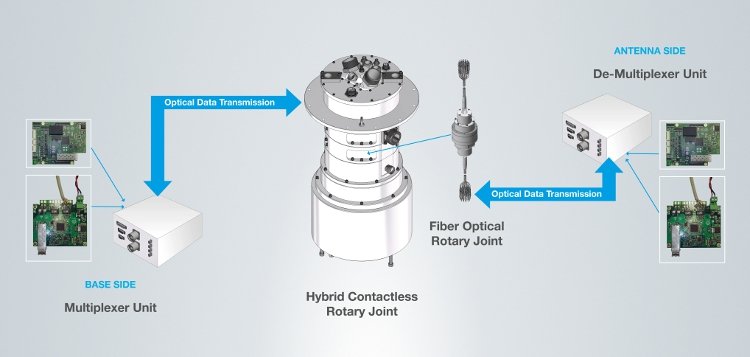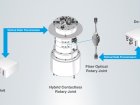News
Fiber Optical Rotary Joints, Non-contacting Standard Components for 1000 Base T and Media Joints for Cooling
Standard non-contacting high speed data transfer for GigE in combination with fiber optical rotary joints and contactless power solutions up to 2 kW finding their way into complex hybrid rotary joints and slip rings.
Radar manufacturers are confirming, that the trend for installing active components directly onto the antenna is still continuing. Traditional radio frequency rotary joints with various frequency bands are being replaced by power slip rings for the power supply and signal transmission paths in order to control the active components on the rotating part of the radar systems and for the down-linking of the received signals.
In addition, there is a strong need for cooling of the rotating antenna due to the power amplifiers on top. This media joints are also integrated into complex hybrid rotary joints.
Multiplexer Technology
SPINNER has already realized several projects with multiplexed signals in combination with a fiber optical transmission or a non-contacting data link. This solution leads to reduced complexity, size and weight of these systems. For example, a 6 channel fiber optical rotary joint with two multiplexer boxes can replace a 200 way signal slip ring.
Hybrid contactless rotary joint with integrated FORJ and multiplexer units at base and antenna side
A 56 way slip ring for a radar application was realized with a complete non-contacting solution. This unit features three 300 Watt 24V DC/DC converters for power, a two channel fiber optical rotary joint and two multiplexer boards for 1000 Base T and 50 ways RS422 and discrete signals.
Real-Time Signal Transmission
The digital and contactless Ethernet transmission modules are standard modules and support 1000 Base T (GigE), 100 Base Tx (Fast Ethernet) and 10 Base T (Ethernet) with auto negotiation, the signal transmission takes place in real-time.
SPINNER is member of the Ethernet POWERLINK Standardization Group
This provides the benefit that the customer is not limited to a certain standard. Other protocols such as CAN bus, Profinet (class A+B) are available, as well as 24V DC/DC converters with 70 Watt, 100 Watt, 300 Watt up to 2 kW with a mean time between failure (MTBF) that is higher than 300,000h.
Sectional drawing of a media rotary joint
As OEM solutions this components are running in the field of industrial plant construction, material testing systems and wind turbines.
In combination with the most advanced fiber optical rotary joints this is a perfect combination for future defense applications.
Fiber Optical Rotary Joints (FORJs)
SPINNER’s portfolio includes 1 channel, 2 channel, 3 – 6 channel and 7 – 20 channel and up to 52 channel solutions. Single and multimode FORJs are used as stand-alone systems for high data rates or in combination with multiplexing methods.
One highlight is the 6 channel rotary joint, the smallest of its kind on the worldwide market, which was developed especially for the simultaneous transmission of analogue signals. It goes without saying that the simultaneous transmission of analogue and (multiplexed) digital signals at a high decoupling and low insertion loss is also possible.
The dual channel is as well the smallest fiber optical rotary joint (mechanical size) with two single mode channels currently available in the world. The patented mechanics result in a market-leading compactness in a small interface and a low weight.
To provide the most compact solutions, SPINNER’s multichannel family is divided into two different housing types: The smallest solutions as mentioned above can be flexibly assembled from 3 to 6 fibers in single-mode and multi-mode or mixed fiber configuration.
In addition to this, a channel count from 7 up to 52 covers the full range of multichannel rotary joints, again in single-mode and multi-mode fiber configurations. With the discrete mounted collimator technology the customer gets superior optical parameter tracking performance with best IL values.
Hybrid units and Integration of Media Joints and/or Encoders
With SPINNER’s capability of self-developed media joints and its design know how with the integration of encoders and other transmission technologies, the company provides solutions for every requirement surrounding hybrid rotary joints.
For highly integrated radar systems with radio frequency (RF) amplifiers directly behind the rotating antenna, access to a cooling liquid is necessary. SPINNER media joint solutions of SPINNER meet this requirement by offering hybrid solutions that transport cooling liquid or simply air through the joint to cool down the active components.
SPINNER – www.spinner-group.com





